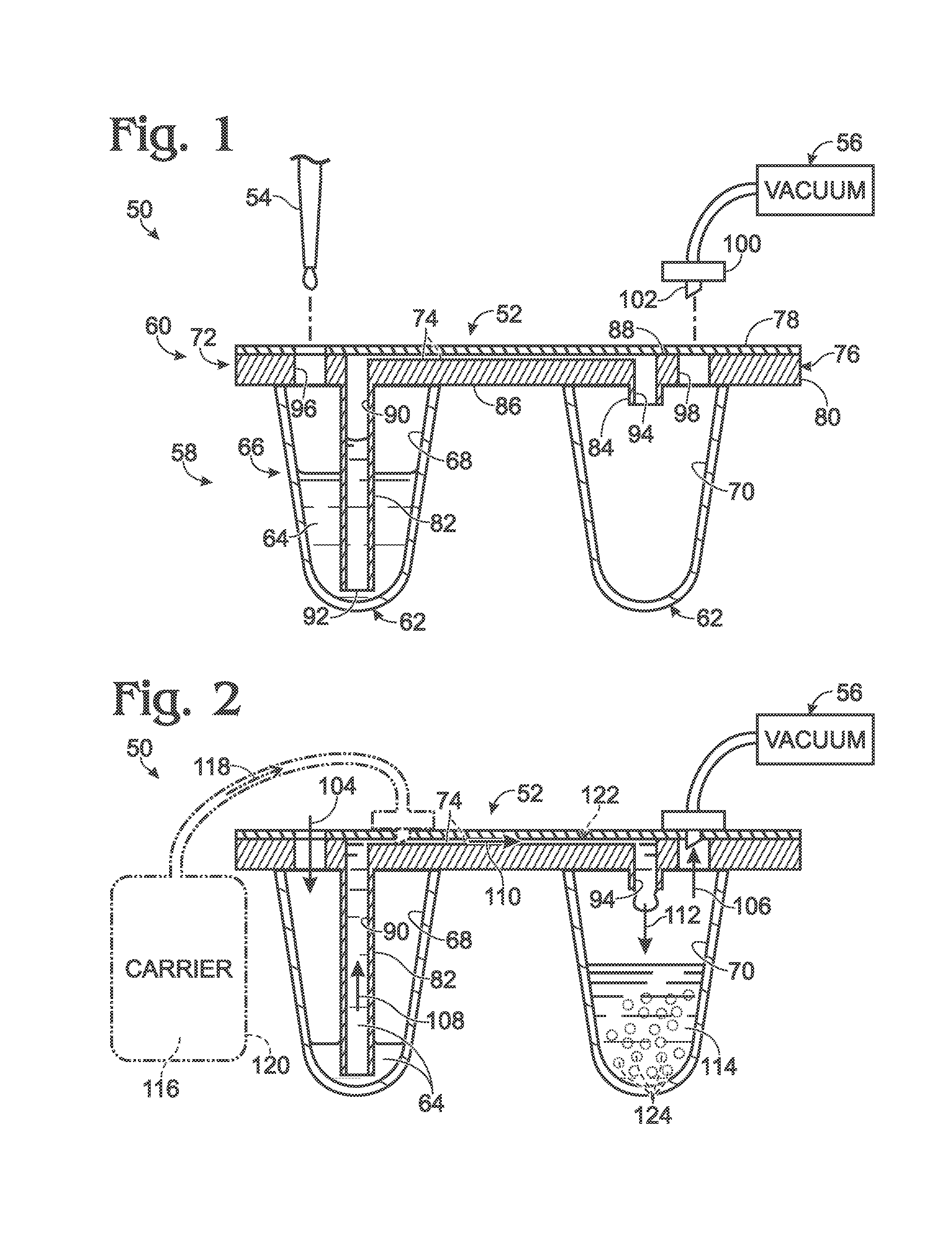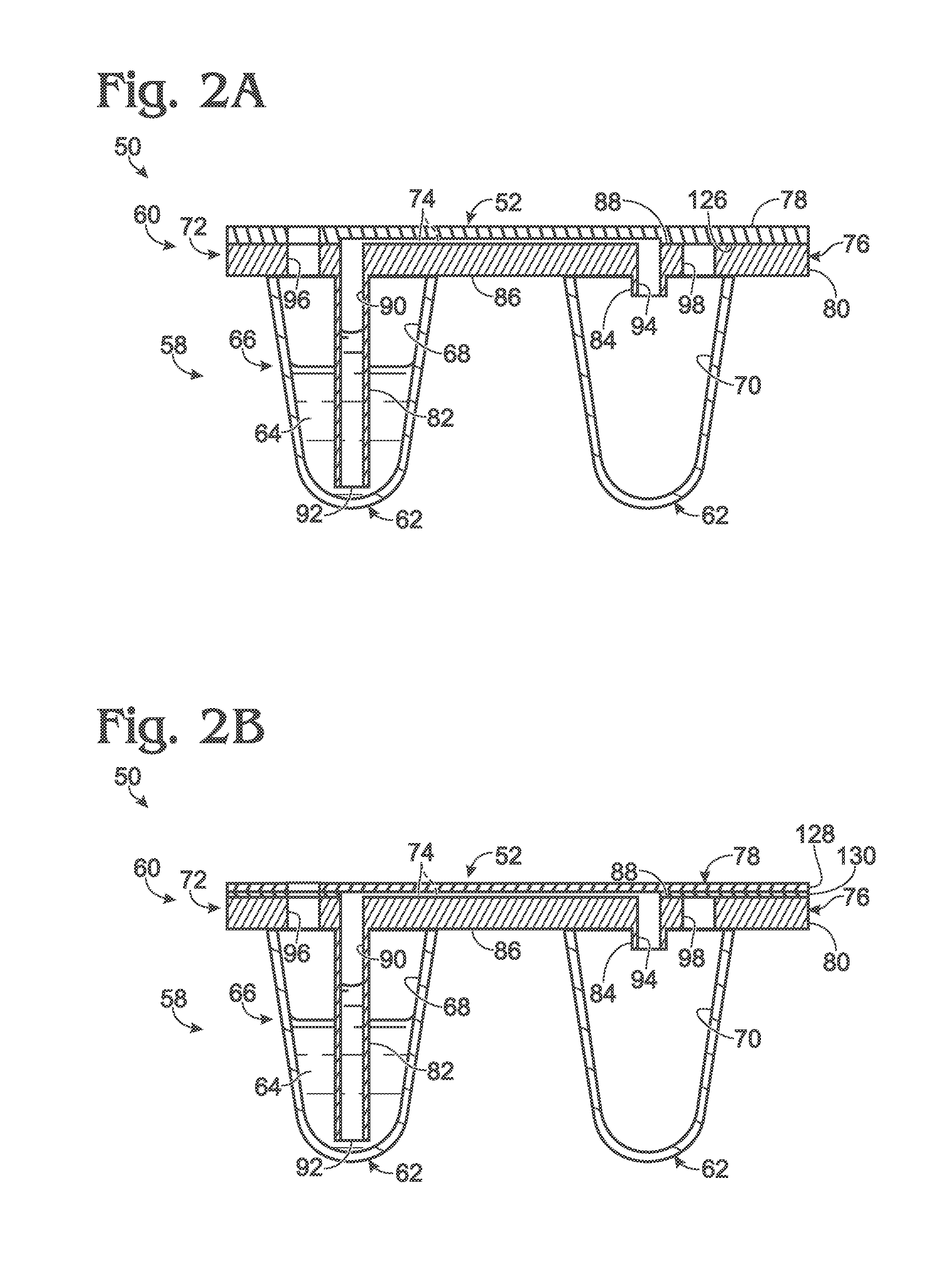Microfluidic system with fluid pickups
a microfluidic system and fluid pickup technology, applied in fluid controllers, biochemical apparatus and processes, laboratory glassware, etc., can solve the problems of increasing cost, emulsion-based assays present technical challenges for high-throughput testing, and more complex instruments
- Summary
- Abstract
- Description
- Claims
- Application Information
AI Technical Summary
Benefits of technology
Problems solved by technology
Method used
Image
Examples
example 1
Droplet Generation Device with Fluid Pickups for Sample and Carrier
[0075]This example describes an exemplary embodiment 152 of microfluidic device 52 for fluid processing system 50 (see FIGS. 1, 2, 2A, and 2B) that is configured for generating an array of emulsions, and also describes exemplary methods of using device 152 to generate and process emulsions; see FIGS. 3-9. The emulsions are generated with samples and carrier fluid transported from wells to channels via fixed, dedicated pickup tubes.
[0076]Device 152 uses hollow protrusions or “fluid pickups” in conjunction with droplet generators, and provides specific examples of droplet generators in which sample-containing droplets suspended in a carrier fluid are generated and transported substantially within a plane.
[0077]As used herein, “substantially within a plane” or “substantially planar” with respect to droplet generation means that the radius of curvature of the space in which droplets are generated and transported is much ...
example 2
Droplet Generation Device with Fluid Pickups and a Carrier Manifold
[0119]This example describes an exemplary embodiment 252 of microfluidic device 52 for fluid processing system 50 (see FIGS. 1, 2, 2A, and 2B). Device 252 is configured for generating an array of emulsions using a fixed, dedicated pickup tube for the sample of each emulsion. The device also has a carrier manifold that receives carrier fluid for all of the emulsions from an off-device (external) carrier reservoir that is fluidically connected to device 252; see FIGS. 10-18.
[0120]FIGS. 10 and 11 show respective assembled and exploded views of device 252. The device may have any combination of the features described above in Section I and / or Example 1. For example, as described above for device 152, device 252 includes a sample-holding portion, namely, a well component 66 defining a plurality of wells. The device also includes a fluid-processing portion, namely, a channel component 72 attached to the well component and ...
example 3
Exemplary Instrument to Interface with a Microfluidic Device
[0135]This example describes an exemplary instrument 310 configured to fluidically connect to microfluidic device 252 and exemplary methods of using the instrument to generate emulsions; see FIGS. 19-21.
[0136]FIGS. 19 and 20 show instrument 310 of microfluidic system 50 for driving and controlling fluid flow within device 252. Instrument 310 may be configured for use with any of the microfluidic devices disclosed herein. Any or all of the operations performed automatically by instrument 310 alternatively may be performed manually by a user.
[0137]Instrument 310 may include a support 312 to hold and position device 252 with respect to at least one processing head 314. Processing head 314 is positioned or positionable over device 252, in alignment with the device, and is configured to interface with the top side of device 252. In the configuration depicted in FIG. 19, the processing head is in a pre-processing, ready position ...
PUM
| Property | Measurement | Unit |
|---|---|---|
| diameter | aaaaa | aaaaa |
| height | aaaaa | aaaaa |
| height | aaaaa | aaaaa |
Abstract
Description
Claims
Application Information
 Login to View More
Login to View More - R&D
- Intellectual Property
- Life Sciences
- Materials
- Tech Scout
- Unparalleled Data Quality
- Higher Quality Content
- 60% Fewer Hallucinations
Browse by: Latest US Patents, China's latest patents, Technical Efficacy Thesaurus, Application Domain, Technology Topic, Popular Technical Reports.
© 2025 PatSnap. All rights reserved.Legal|Privacy policy|Modern Slavery Act Transparency Statement|Sitemap|About US| Contact US: help@patsnap.com



